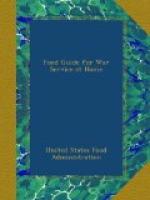The outer covering, called bran, is made up of several layers. This is rich in important mineral salts, and the rest is largely cellulose, or woody fibre.
The germ is the small part from which the new plant will develop. Here the small amount of fat in the kernel is stored.
The largest part of the kernel, called the endosperm, contains the nourishment to be used by the plant as it begins to develop. This is mostly starch, with some protein. It is the part of the wheat, for instance, which is chiefly used to make our white flour.
The kind of flour made depends on how much and what parts of the kernel are used. Graham flour is manufactured by grinding practically all of the wheat-kernel—a 100-per-cent use of the grain, called 100-per-cent extraction. Some people still fail to realize that Graham flour and Graham bread are wheat, perhaps because of the different name and brown color. The so-called “whole-wheat” flour is often 95 per cent of the kernel only, but may be as little as 85 per cent, depending on the amount of the bran and germ removed in the making.
Ordinary white flour contains the endosperm alone, with practically none of the bran and germ. Some brands before the war used up as little as 56 per cent of the wheat, leaving the rest of it to be turned into lower-grade flours and cattle-feed. White flour thus uses less of the wheat for human food than Graham or whole-wheat flour.
Yet to convert all the country’s wheat into Graham flour would not be a wheat-saving measure, because it is not so well suited to our trade conditions. Graham flour, for one thing, does not keep so well as flour of lower extractions, as the fat in the germ may become rancid in a comparatively short time. Flour in this country is often thirty days or longer in transit and may be months in warehouses, stores, and homes. A flour to be satisfactory under extreme conditions here or for shipment abroad must keep at least six months—too long to be sure that Graham flour will keep. In small countries like England, where flour is used up more promptly, a high extraction is more practicable than in the United States.
Moreover, while Graham and whole-wheat flours with their larger quantities of mineral salts are a more desirable food for some people than white flour, they are occasionally irritating to people with weak digestions, so that it would be unfortunate to have only these flours on the market.
The Food Administration, therefore, has considered that the most effective use of our wheat could be obtained by forbidding the manufacture of fancy flours of low extraction and making all flour contain at least 74 per cent of the wheat. This still gives a fine white flour that keeps well and is difficult to distinguish from that on the market before the war.
To help in the enforcement of its flour rulings, the Food Administration has licensed all mills and elevators which handle over 100 barrels of flour a day. If the rulings of the Food Administration are not obeyed the license may be taken away, and the business closed. The hoarding of flour has been stopped by prohibiting mills, elevators, and bakers from having more than 30 days’ supply on hand.




